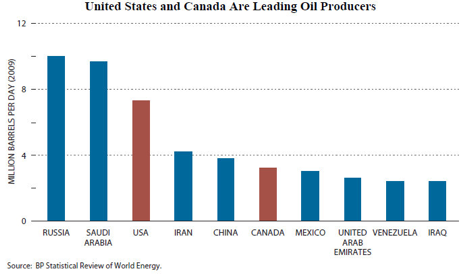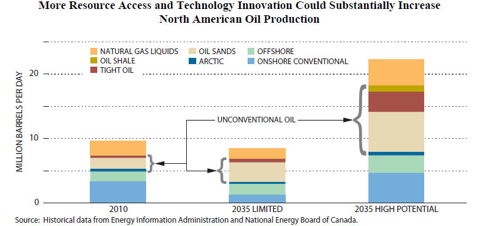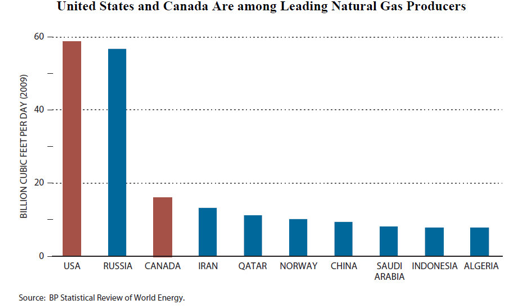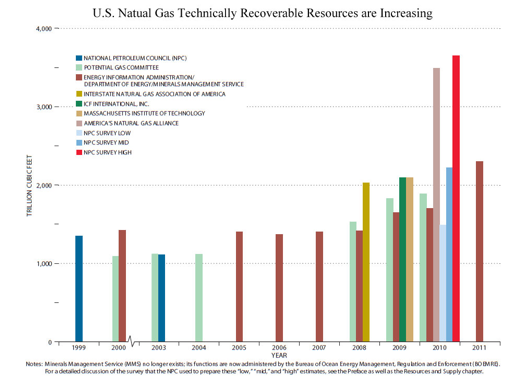Guess what? America could have enough oil resources to meet today’s oil demand levels in the future for decades without importing from unfriendly foreign countries. That is the conclusion of a new report from the National Petroleum Council (NPC).[i] The report also finds that America has huge volumes of natural gas that can meet decades of demand. That statement should come as no surprise since hydraulic fracturing has opened up vast shale gas deposits. But it might be a surprise to some that NPC also finds that hydraulic fracturing will open up vast oil resources to development as well.
The NPC Study
The NPC is an advisory group of industy, academic, government and other officials that are tasked by the Secretary of Energy to provide advice on oil and natural gas issues. In 2009, DOE Sectretary Steven Chu requested the NPC to evaluate oil and natural gas resources based on the following four concepts: economic prosperity, environmental sustainability, energy security, and prudent development.
Some of the report highlights are:
Oil
- The United States is the world’s third largest oil producer, after Russia and Saudi Arabia. And, Goldman Sachs indicated that it expects the United States to take the top spot as the largest oil producer by 2017.[ii]
- Together the United States and Canada produce 4 percent more oil than Russia, the world’s largest oil producer.
- Sources of oil in the United States include 1.) tight oil such as in the Bakken and Eagle Ford formations, 2.) oil offshore in the Gulf of Mexico and off the Atlantic and Pacific Coasts, 3.) oil in the Arctic, and 4.) shale oil deposits in Colorado, Utah, and Wyoming. Development of these resources will require assistance from the federal government through their inclusion in the 2012-2017 leasing program. Their development will also require sustained investment, advanced technology, and new pipelines and other infrastructure.
- The Trans Alaskan Pipeline System will be threatened by decommissioning unless new oil resources are developed in the Arctic to keep the pipeline’s volumes from reaching below minimum operating levels.
- Two scenarios were evaluated: constrained (limited) and unconstrained (high potential). The constrained scenario assumed limited resource access, constrained technology development, and greater regulatory barriers compared to the unconstrained scenario that assumed more access and substantial advances in technology. (See graph below for results.)
- Oil from shale formations, such as Bakken shale in the northern United States and the Eagle Ford shale in Texas, listed as tight oil in the graph above, could produce 2 million to 3 million barrels of oil per day by 2035.[iii]
- The United States and Canada combined could produce up to 22.5 million barrels of oil per day, which is today’s demand level. With demand growth, some oil imports from overseas would be needed.
- Americans will need natural gas and oil for a major portion of its energy requirements for the foreseeable future even if the United States uses energy more efficiently, diversifies its energy mix, and moves towards lower carbon fuels.
Natural Gas
- The United States is the world’s largest producer of natural gas.
- Together the United States and Canada produce 25 percent of the world’s natural gas supply.
- Hydraulic fracturing and horizontal drilling have brought about the reassessment of the natural gas resource base with substantially higher levels than just a few years ago.[iv]
- The natural gas resource base could supply more than 100 years of demand at today’s consumption levels and more than 5 decades at greatly expanded levels.
- Technological success in the United States with shale gas development has opened opportunities worldwide in China, Poland, the Ukraine, South Africa, and elsewhere.
- Natural gas can be part of the solution to lower emissions of greenhouse gases since it is less carbon intensive than coal for electric generation.
The NPC recommends:
- Classifying natural gas as a “clean fuel” for purposes of clean energy standards.
- Development of environmental footprints and full fuel cycle impacts in comparing different energy sources and technologies.
- The creation of industry-led, regional “councils of excellence” to make sure the best practices for safe natural gas development are being shared among all companies.
- Development of government regulations that balance prescriptive and performance-based regulations
- Maintaining tailored royalty relief programs that encourage early development and production.
- Allowing longer lease times for “frontier” areas, such as the ultra-deep water and Arctic where planning and operations are significantly more challenging.
Conclusion
The United States is currently the world’s largest producer of natural gas and the world’s third largest producer of oil. If the vast oil resources in the United States were allowed to be developed with appropriate incentives for development, the United States could be the world’s largest oil producer. With additional oil supplies from Canada, the United States could almost become independent of overseas oil. Given that the United States will need oil and natural gas for the foreseeable future, why not allow the industry to make this forecast a reality?
[i] The National Petroleum Council, Prudent Development: Realizing the Potential of North America’s Abundant Natural Gas and Oil Resources, Draft Report, September 15, 2011, http://downloadcenter.connectlive.com/events/npc091511/Report_excerpts-91511.pdf
[ii] Houston Chronicle, Report says we have more oil than we thought, September 15, 2011, http://www.chron.com/default/article/Report-says-we-have-more-oil-than-we-thought-2173154.php
[iii] Fuel Fix, Report: U.S. has “surprisingly” large amount of oil, September 15, 2011, http://fuelfix.com/blog/2011/09/15/report-u-s-has-surprisingly-large-amount-of-oil/#loopbegin
[iv] The National Petroleum Council, Prudent Development: Realizing the Potential of North America’s Abundant Natural Gas and Oil Resources, A Comprehensive Assessment to 2035 with Views through 2050, September 15, 2011, http://downloadcenter.connectlive.com/events/npc091511/Prudent_Development-091511.pdf







